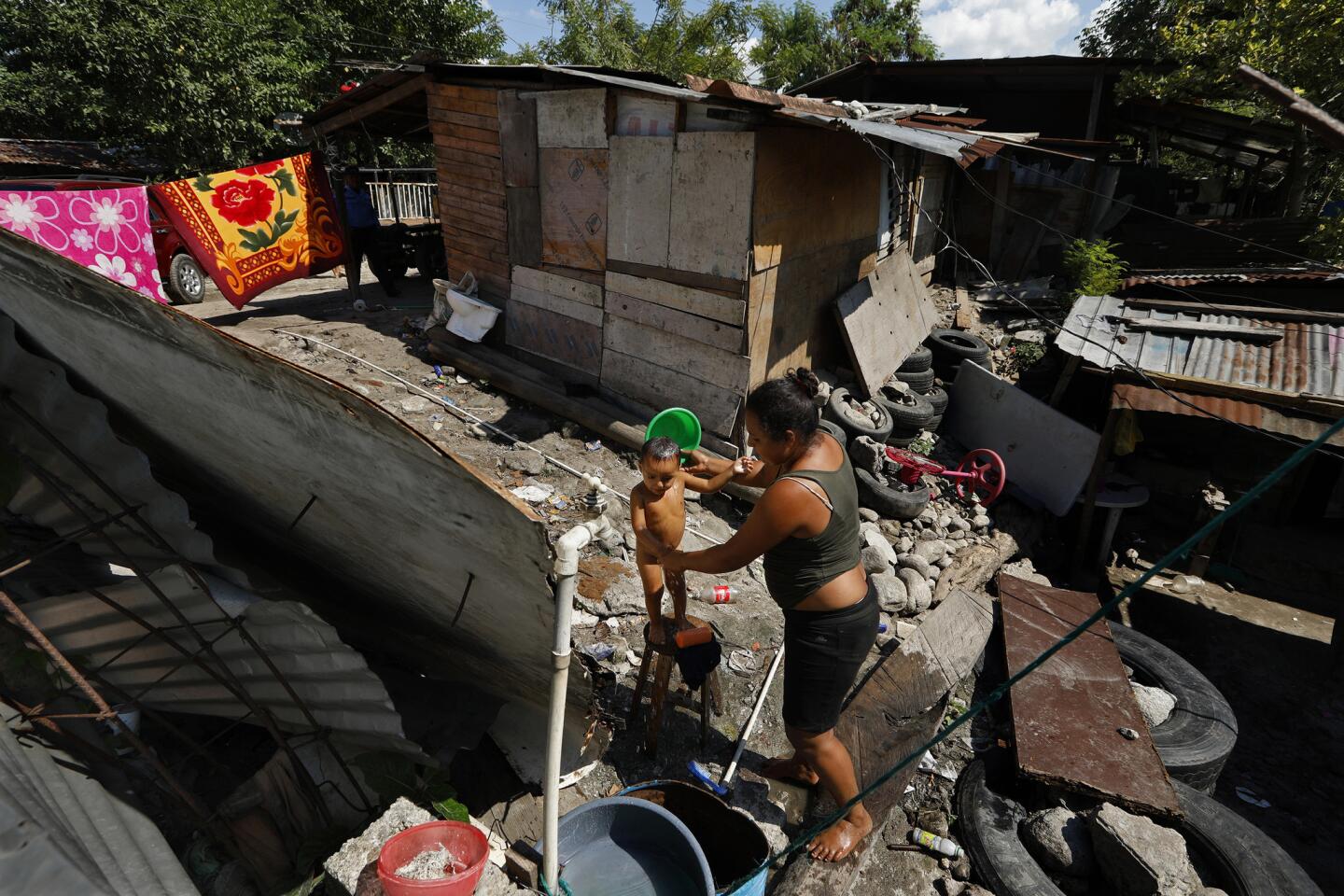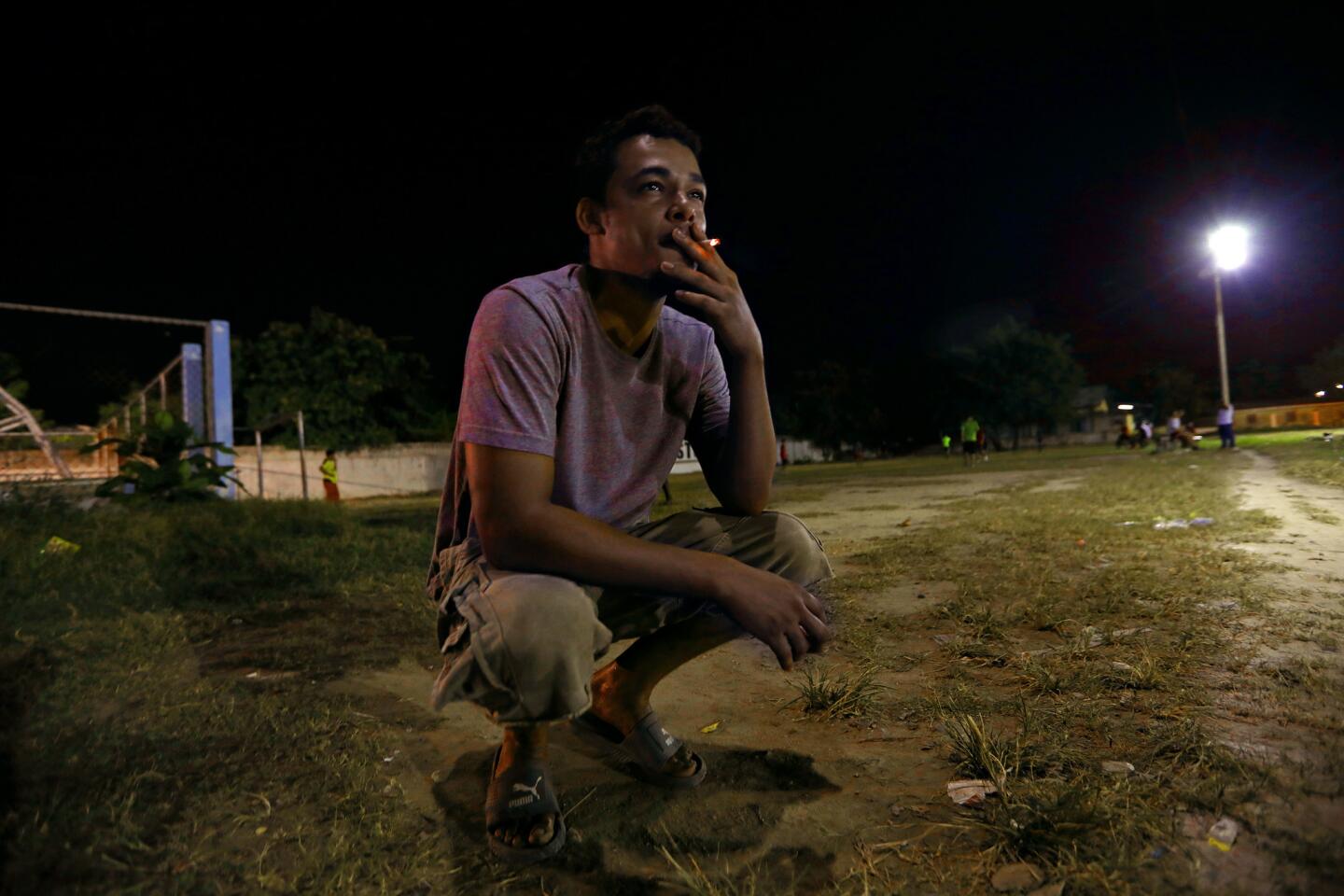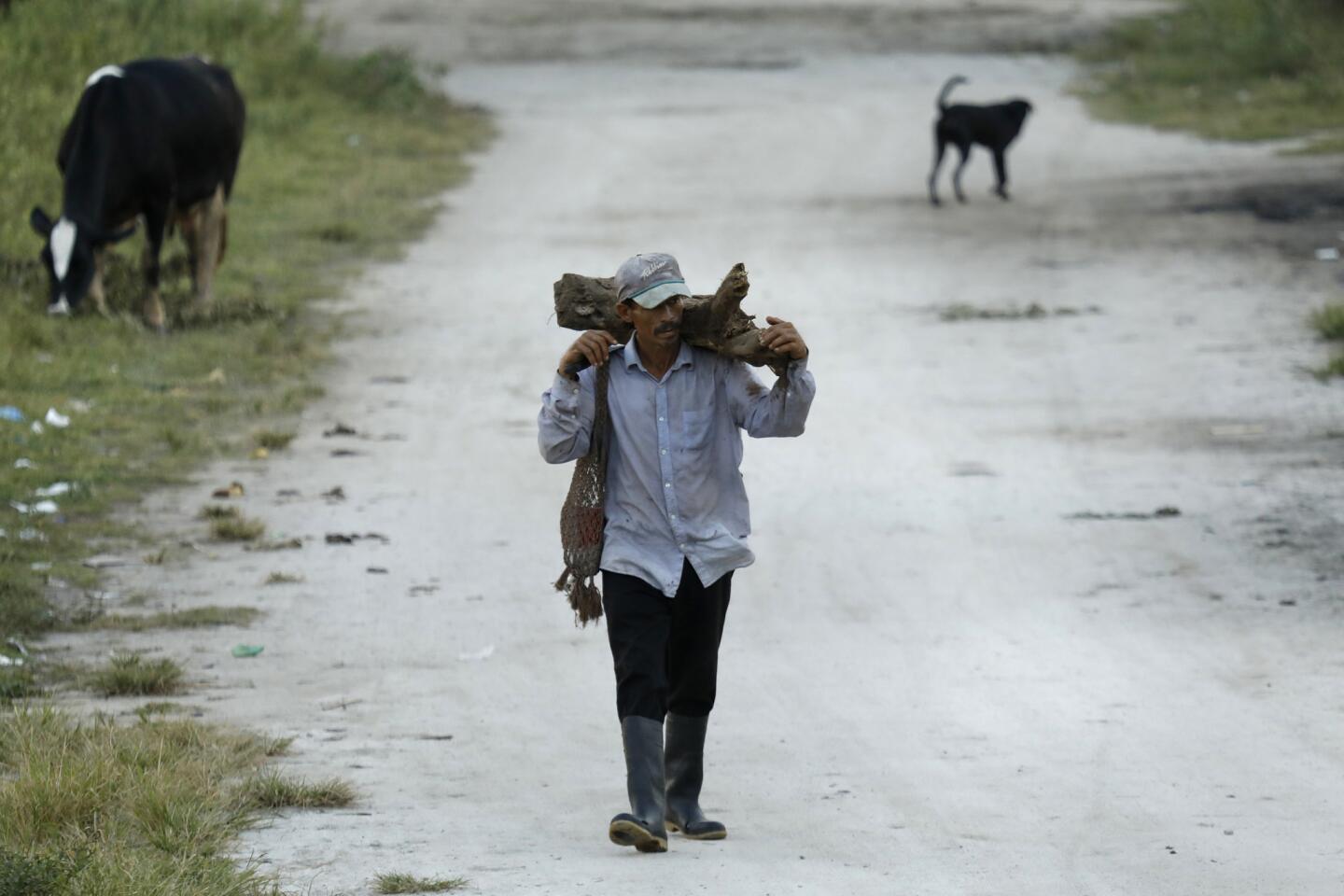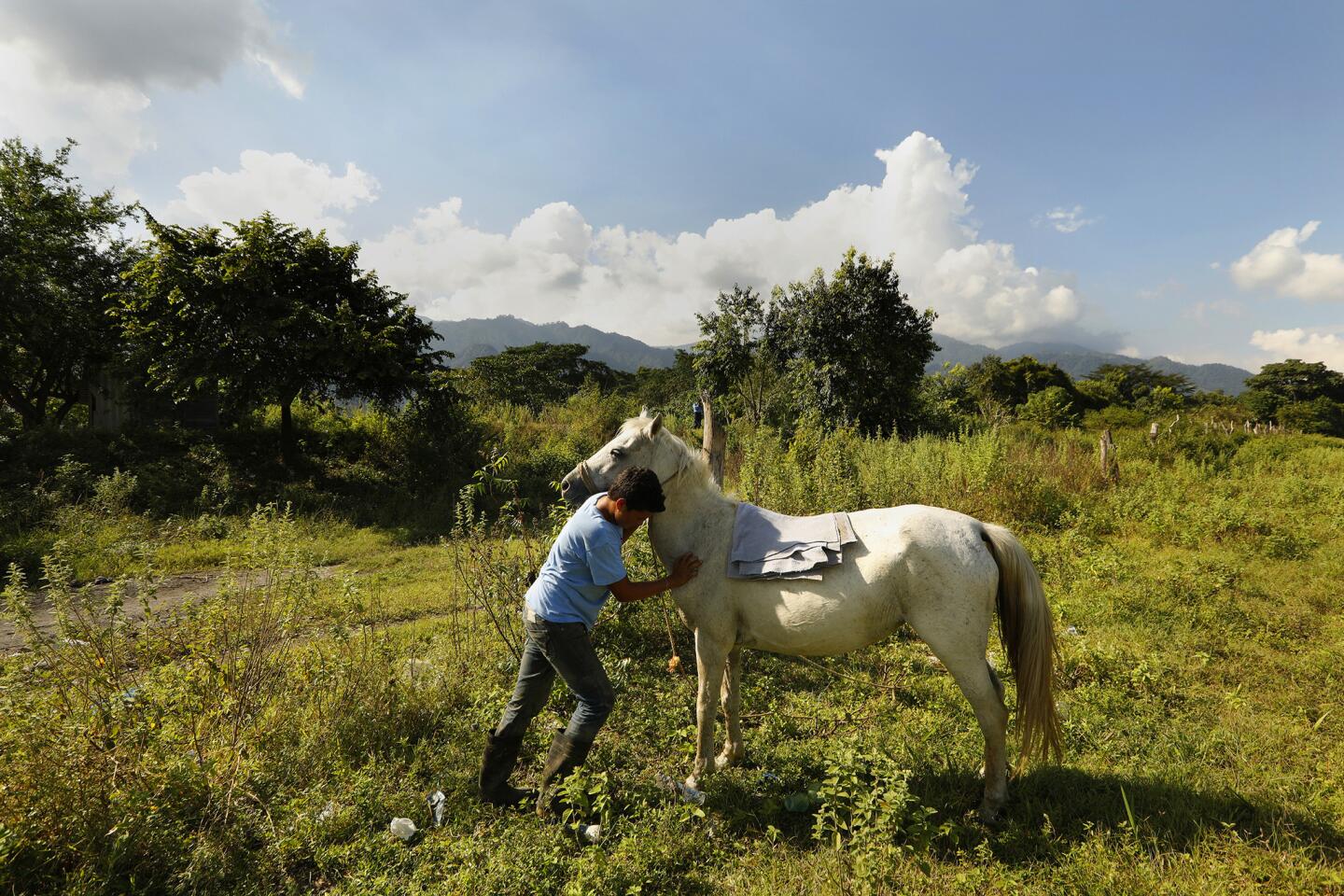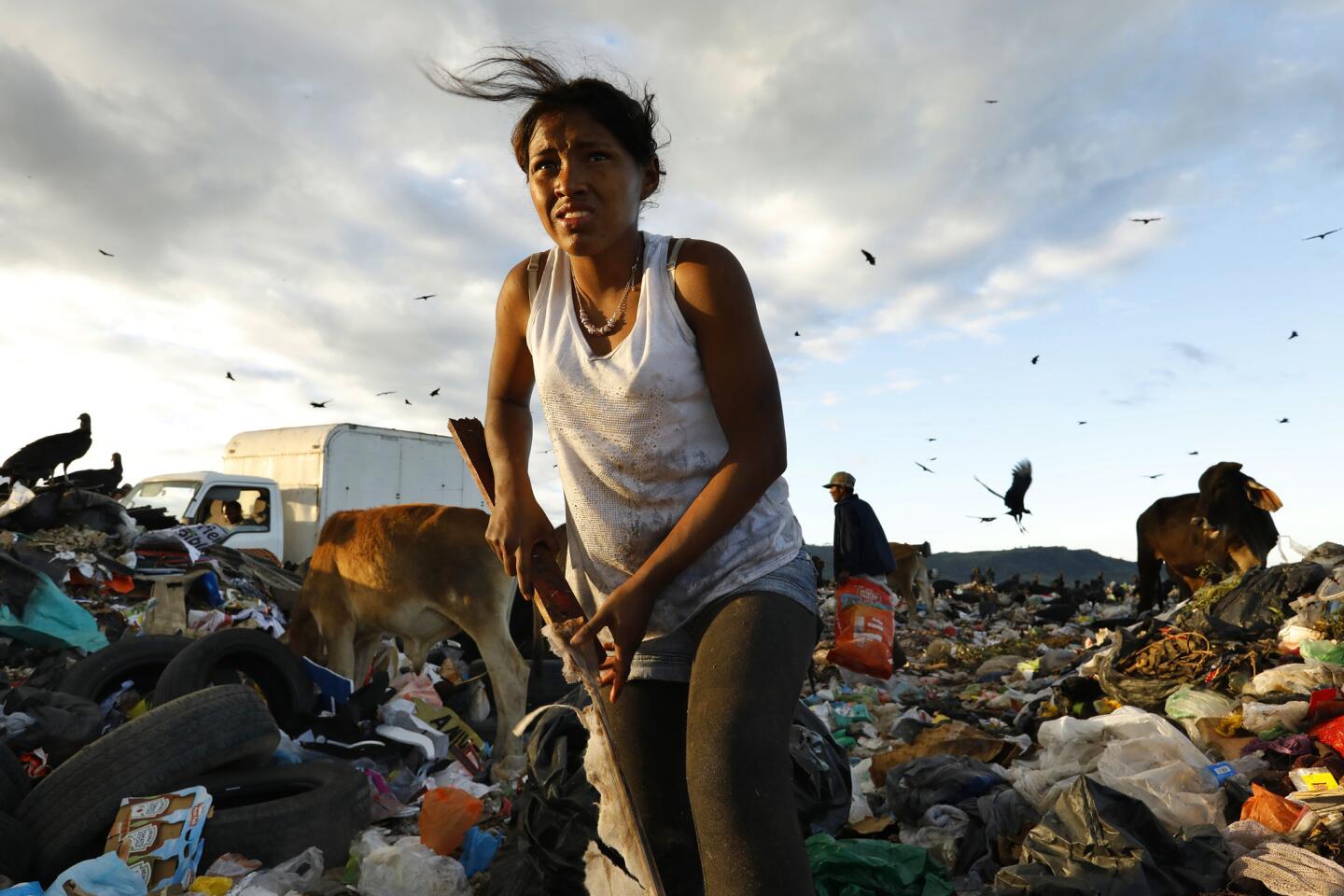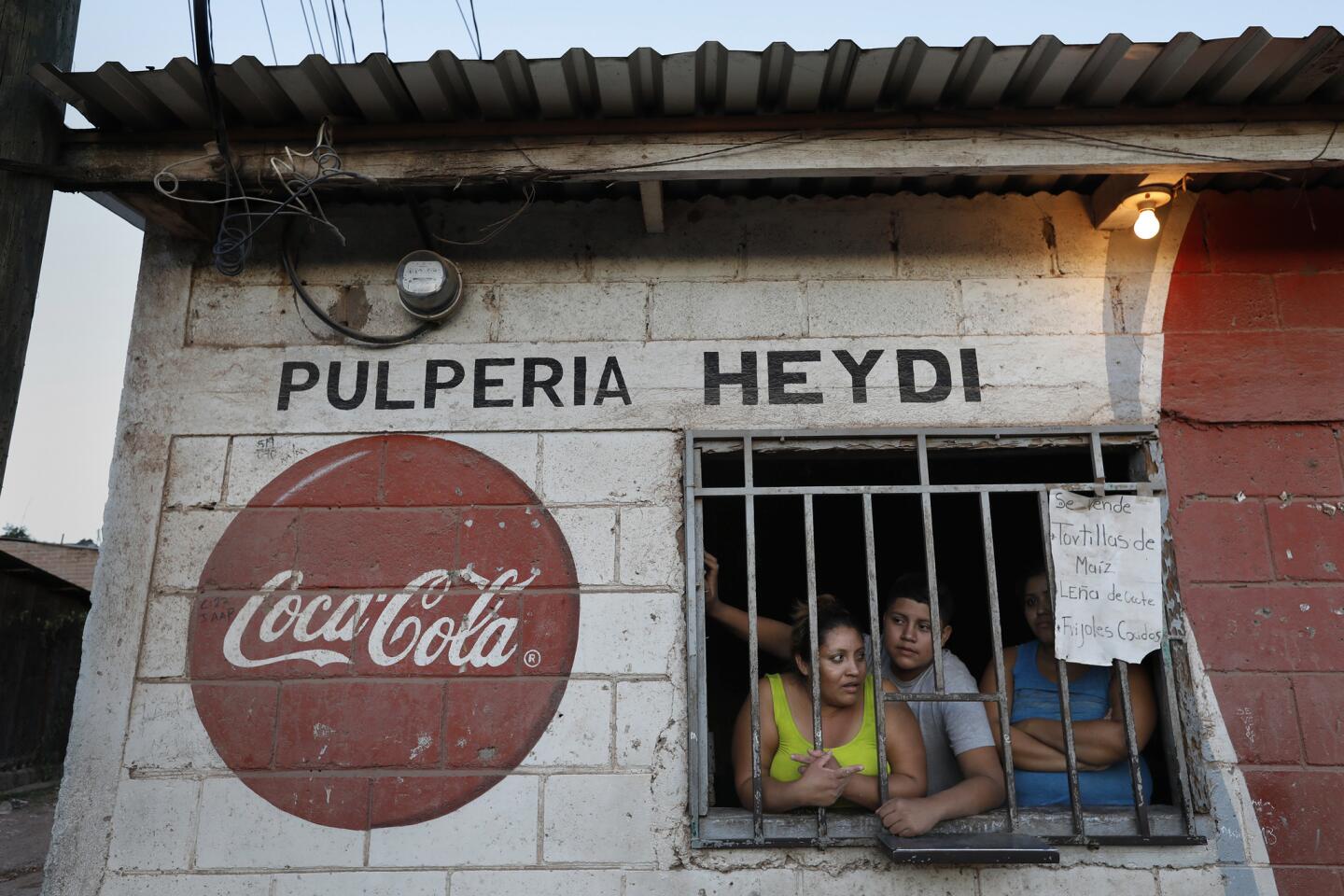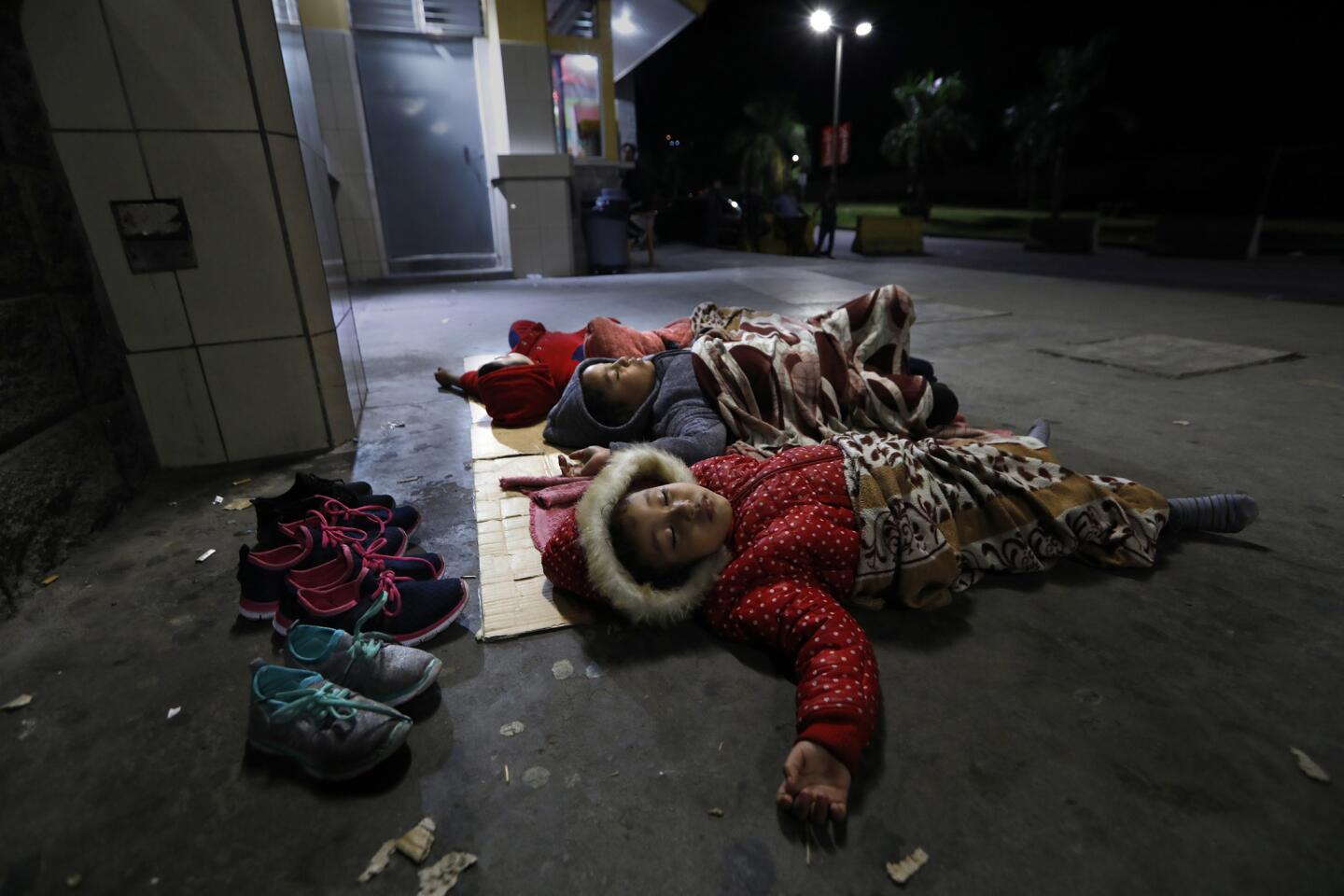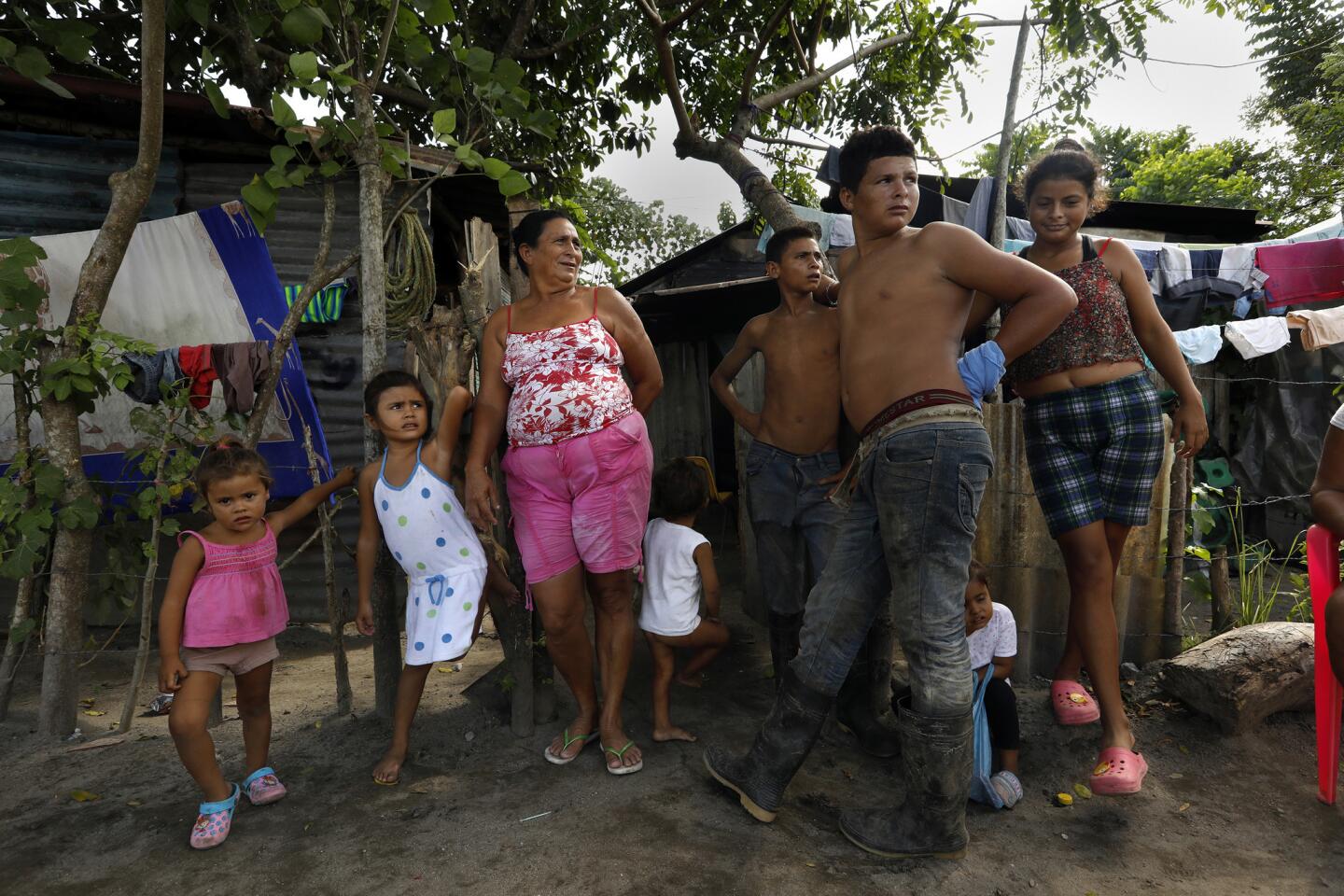Homicides have fallen dramatically in Honduras. So why are people still fleeing?

Despite the impressive reduction in homicides, Hondurans have continued to leave their country in droves in recent years. Some 258,000 of them left in 2016, according to Honduras’ institute of statistics.
- Share via
Reporting from San Pedro Sula, Honduras — Less than a decade ago, when Honduras was the homicide capital of the world and this industrial city was the homicide capital of Honduras, the neighborhood of Rivera Hernandez was usually deserted after dark. Residents cowered in their homes, hiding from murderous gangs.
Today, there is less to fear. On a recent warm evening, teenagers kicked around a soccer ball as a vendor selling yam chips circled with a pushcart and a high school marching band practiced nearby.
The transformation is thanks in part to hundreds of millions of dollars the United States has spent to help Honduras fight crime.
The aid has flowed based on a simple hope: If the streets were safer, fewer people would migrate north.
But the reality has proved much more complicated. Though the country’s homicide rate has fallen dramatically, the number of people fleeing Honduras in recent years has not — a fact on display this fall when thousands of people joined so-called migrant caravans and began trekking north.
The reasons for “the exodus,” as many in Honduras have begun referring to the recent mass migration, go far beyond violence. The economy is a shambles, with nearly two-thirds of the labor force either unemployed or underemployed. Endemic corruption and political instability have also been major factors.
“We’re seeing an accumulation of crisis upon crisis upon crisis,” said Lester Ramirez, director of investigations at the Assn. for a More Just Society, a nonprofit that has received U.S. aid for its anti-violence work. “A lot of people have just lost hope.”
Among Hondurans deported from the U.S. in 2016, 96% cited economic hardship as a main reason for migrating, according to the Pew Research Center.
A 2018 poll by a Honduran think tank, the Reflection, Research and Communication Team, found that among those who had a family member leave in the last four years, 83% said the reason was economic insecurity, compared with 11% who said it was violence.
“The caravan has exposed the reality of poverty, unemployment and repression,” said Honduran economist Hugo Noe.
The best available measure of illegal immigration to the United States is how many people are caught at the border, and from fiscal year 2011 to 2014, the number of Hondurans who were detained by the U.S. Border Patrol each year increased from 11,270 to 90,968. Many were children traveling on their own who said they were fleeing gangs.
In response, the U.S. government dramatically increased aid to Honduras as well as to Guatemala and El Salvador, which were also sending large numbers of migrants, appropriating $2.1 billion since fiscal 2016, according to the Congressional Research Service.
The largest share has gone to crime fighting. In 2016 and 2017, Honduras received nearly $204 million for violence prevention, anti-drug efforts, improvements to the justice sector and other security measures, according to the Washington Office on Latin America think tank.
By comparison, $112 million funded economic growth, rural and social development and food security.
The security aid was especially welcomed by President Juan Orlando Hernandez, who had campaigned on an anti-violence platform and then ordered the military and the police to intensively patrol high-crime neighborhoods.
Killings, which had already been on the decline for three years, continued to drop. Overall, the number of homicides per 100,000 people fell from a peak of 87 in 2011 to 44 last year, according to the Violence Observatory at the National Autonomous University of Honduras.
In the Rivera Hernandez neighborhood, which has seen significant U.S. investment, homicides have been cut about in half over the last several years, said Danny Pacheco, an evangelical pastor who runs an anti-gang program focused on improving the community’s relationship with police.
He said his group’s outdoor movie screenings and gangs-versus-cops soccer matches, which are funded in part by the U.S., usually guarantee “at least a few hours of peace.”
Still, some neighborhood residents joined the recent migrant caravans, Pacheco said.
He said some people leave because violence in Honduras, though reduced, remains too much to bear. The country’s homicide rate is nearly nine times that of the United States and is still among the worst in the world.
Residents in many parts of Honduras must stay aware of the invisible lines that delineate gang turf, and extortion by gangs is rampant. More than 1,900 people were forced to flee their homes in 2016 and 2017 because of death threats, extortion or other gang activity, according to Honduran human rights officials.
“It’s still unacceptable,” Pacheco said.
But he named more mundane factors as bigger drivers of immigration: skyrocketing energy bills, rising food costs and lack of work.
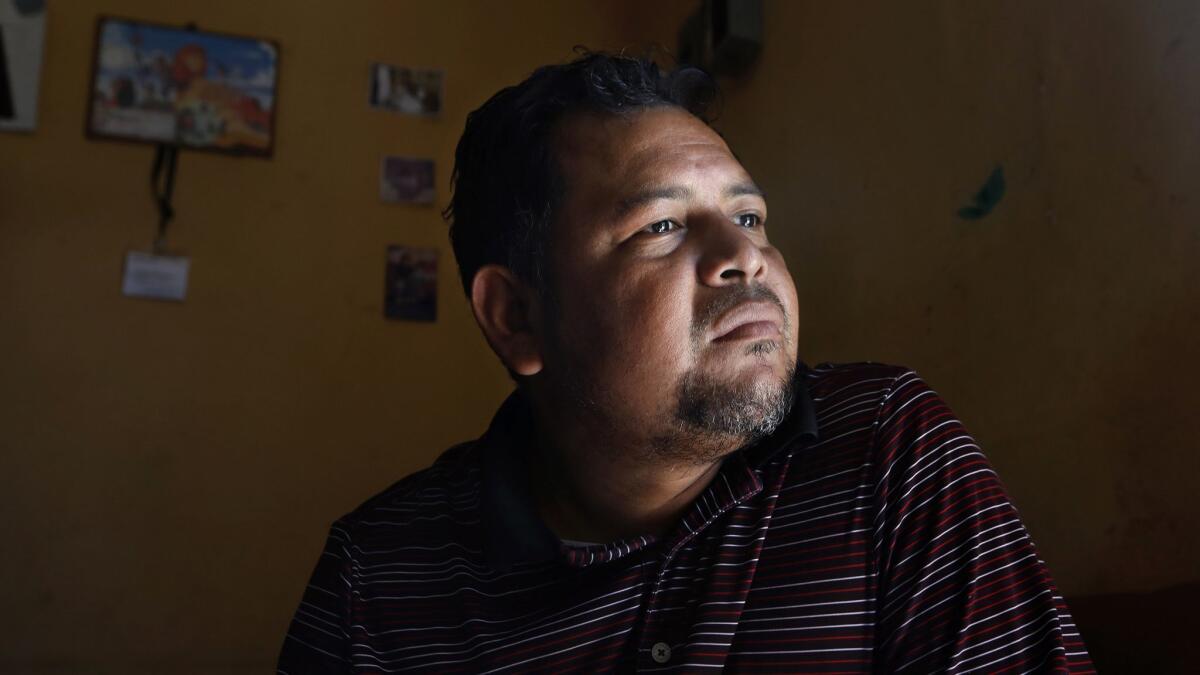
It’s apparent every time he tries to persuade a gangster to leave behind a life of crime.
“I can ask them to leave the gang, but I don’t have anything else to offer them,” he said. “Even if they graduate high school, they can’t get a job.”
Political instability and corruption have also hurt the economy and fed the desire to flee Honduras.
The political system has been in turmoil since 2009, when a coup tacitly supported by the United States forced the president into exile. Hernandez, the current president, was reelected last year in a vote that international observers said was marred by fraud. It spurred nationwide protests in which at least 16 people were killed by state security forces.
As migrants marched north this fall, many shouted an anti-Hernandez chant: “Out, JOH!”
The U.S. has supported anti-corruption efforts, including a purge of more than 5,000 national police officers and the training of recruits. It has also given at least $10 million to the Mission to Support the Fight Against Corruption and Impunity in Honduras, which was created in 2016 after hundreds of millions of dollars were embezzled from the country’s social security institute.
But reforms proposed by the group have been obstructed by Honduran legislators, some of whom the group is investigating.
And new high-profile corruption scandals continue to come to light. Last month, U.S. prosecutors brought drug trafficking charges against the president’s brother, who they say moved cocaine through Central America with the help of Honduran authorities.
When Congress boosted aid to Central America, it mandated that a portion of the money be withheld until local governments proved they had taken concrete steps to promote human rights and curb corruption.
The State Department certified that Honduras met those conditions in fiscal years 2016 and 2017.
Still, many people are leaving because they don’t trust that things will get better, said Rodolfo Pastor, a spokesman for the country’s main opposition party, Libre.
“The majority of the population is probably willing to leave if they can,” he said. “And most who can are.”
Apprehensions of Hondurans at the border fell significantly from fiscal 2014 to 2015, from 90,968 to 33,445 — perhaps in part because of U.S.-funded messaging campaigns that preceded the big increase in aid and warned about the risks of migrating.
But the decline didn’t last. The Border Patrol apprehended 52,952 people from Honduras in fiscal year 2016 and 47,260 last year.
The government has not released complete figures for fiscal year 2018, but the available data show a rise over 2017 in one important measure: The number of people who were apprehended while traveling in family units that include at least one child climbed 76% to 39,439.
In recent years, families have accounted for fewer than half the apprehensions.

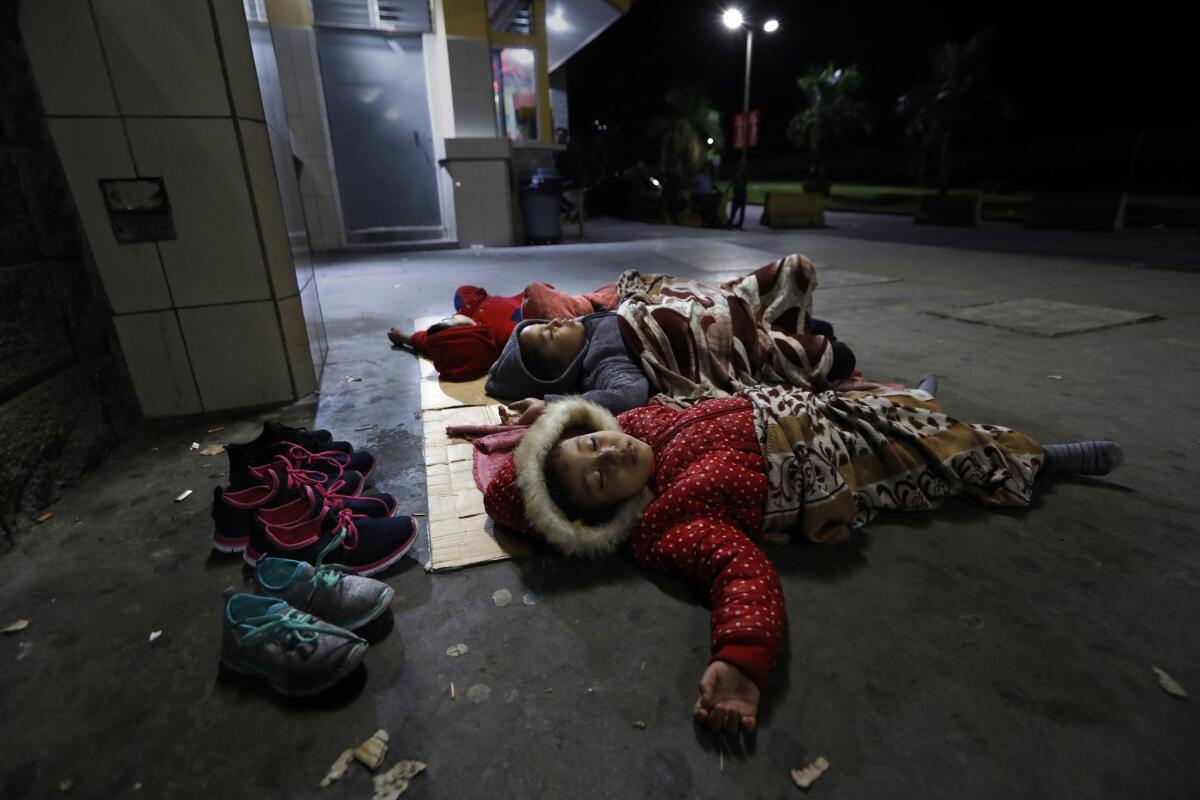
At the main bus terminal in San Pedro Sula, hundreds of Hondurans begin the journey north every day.
On a recent evening, 26-year-old Elminton Hernandez sat on the curb, cradling his 2-year-old son in his skinny arms. Nearby, another migrant set down coats for his four children to sleep on as they waited for a bus to Guatemala.
Hernandez said leaving would mean his son wouldn’t grow up to join a gang. But the main thing they were fleeing was hunger.
When there was work in the palm fields, Hernandez earned $8 a day. But after a recent drought, work had been harder to find, and he struggled to feed his family.
“If you eat breakfast, you can’t eat dinner,” he said.
With more Honduran migrants arriving at the U.S. border, the number of people requesting asylum has also risen. In fiscal years 2011 to 2016, a total of 7,350 Hondurans applied for asylum, a 166% increase compared with the five years before that, according to the Transactional Records Access Clearinghouse, a Syracuse University think tank that collects federal data.
During that time period, 80% of asylum claims were denied.
To win asylum, applicants must prove they are at risk of violence based on their religion, race, nationality, politics or “membership in a particular social group,” which in the past has included being a victim of gang violence.
Immigration law does not consider being poor or unemployed a valid reason.
The Trump administration has sought to exclude gang violence as a reason to grant asylum. It also argues that migrants have incentive to make false asylum claims because they are allowed to live in the United States while their cases are pending.
At the same time, the administration has sought to scale back assistance to the region.
The White House requested $66 million for Honduras in its 2019 budget. This fall, Trump threatened to cut aid to the region all together if Honduras, El Salvador and Guatemala did not stop migrant caravans from traveling north.
That could mean the loss of programs like the one that trained Domingo Escalon in community policing.
Once largely confined to his police station, Escalon now spends his days strolling the narrow dirt streets of the San Pedro Sula slum known as Bordo del Rio Blanco.
Men and women wave at him, and barefoot children shout his name, “Escalon!”

The new approach — being a steady and helpful presence in the neighborhood instead of appearing only when something bad happens — has helped reduce violence there, he said.
On a recent afternoon, he stopped by a small shack on the edge of a green cow pasture where Reina Margarita Ordoño, 49, raised her 10 children.
Escalon greeted her, then asked whether she had heard from her 24-year-old son, Elvin. Ordoño shook her head no.
With construction work in Honduras unsteady and no hope of paying for school for his three children, Elvin hoped to make money in the United States.
His mother begged him not to leave. “It’s better to be in your home eating only tortillas and salt than living in a strange place,” she said.
He left anyway. No one in the family has heard of him since.
Twitter: @katelinthicum
More to Read
Sign up for Essential California
The most important California stories and recommendations in your inbox every morning.
You may occasionally receive promotional content from the Los Angeles Times.

